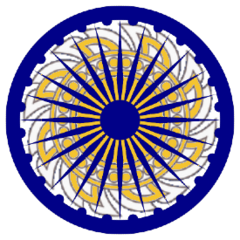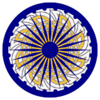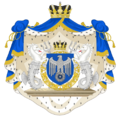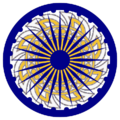Charsidhanism: Difference between revisions
(Created page with "{{WIP}} {{Region icon Kylaris}} Category:Rajyaghar Category:Politics of Rajyaghar{{Infobox political party | name = Charsidhanism | native_name = चरसिडान...") |
mNo edit summary |
||
| (2 intermediate revisions by the same user not shown) | |||
| Line 31: | Line 31: | ||
==Symbolism== | ==Symbolism== | ||
[[File: Charsidhan.png|100px|right|thumb| | [[File: Charsidhan.png|100px|right|thumb|Charsidhan Chakra]] | ||
The ''Charsidhan Chakra'', the symbol of charsidhanism, | The ''Charsidhan Chakra'', the symbol of charsidhanism, is a combination of a {{wp|Ashoka Chakra|spoked wheel}} and the [[Prakeet|vanshprakeet]] of the Rajana Clan. The spoked wheel represents the unity of the Union States of Rajyaghar with the spokes depicting the union states and the wheel representing their unity as together they form a functioning device essential to progress and industry. The inclusion of the vanshprakeet of the Rajana Clan is owed to their position as the ruling family of the Kingdom of Rajyaghar. The inclusion of the Royal Family's prakeet also represents the principle of monarchism; a core principle of charisdhanism. | ||
When independence was first announced to be achieved upon the conclusion of the [[Solarian War]], the nation's forefathers began to develop the symbols, flags and seals for the soon-to-be independent Rajyaghar. To promote charsidhan, it's symbol would be | When independence was first announced to be achieved upon the conclusion of the [[Solarian War]], the nation's forefathers began to develop the symbols, flags and seals for the soon-to-be independent Rajyaghar. To promote charsidhan and enshrine it as the national ideology, it's symbol would be adopted as the [[Coat of Arms of Rajyaghar#National_Emblem|National Emblem]], be incorporated into the [[Coat of Arms of Rajyaghar|Royal Coat of Arms]] and feature prominently on various national and union state symbols. | ||
===Use of the Charsidhan Chakra=== | ===Use of the Charsidhan Chakra=== | ||
<gallery> | <gallery> | ||
GreaterRajyaniRoyalArms.png|Royal Coat of Arms | |||
Charsidhan.png|National Emblem | |||
RajyagharSeal.png|State Emblem | |||
</gallery> | </gallery> | ||
{{Rajyaghar}} | {{Rajyaghar}} | ||
Latest revision as of 21:35, 10 July 2021
This article is incomplete because it is pending further input from participants, or it is a work-in-progress by one author. Please comment on this article's talk page to share your input, comments and questions. Note: To contribute to this article, you may need to seek help from the author(s) of this page. |
Charsidhanism चरसिडानिज्म | |
|---|---|
 | |
| Adopted | October 17, 1946 |
| Ideology | Territorial Nationalism Rajyani Nationalism Monarchism Militarism |
| Country | |
Charsidhanism (Matrabashi: चरसिडानिज्म), sometimes referred to as "the four principles", is a rajyani ideology that, since independence in October 1946, has been the national ideology of the Kingdom of Rajyaghar. Charsidhanism, the implementation of the charsidhan philosophy, was developed during the Solarian War in a bid to ensure national unity following independence, to act against growing pan-satrian from neighbouring Ajahadya, and to provide military strength to protect against invasion. Specifically, charsidhanism was developed to encompass the four principles of territorial nationalism, rajyani nationalism, monarchism and militarism.
The absence of ethnic nationalism and religious nationalism from the ideology gained it support from the ethnnic minority groups in the south and east of Rajyaghar, particularly in Pinjar and Zulmat as well as support from the irfanic and badi groups across the country. The inclusion of monarchism was a compromise to the tulyatan majority who feared a minority head of state.
Origins
Four Principles
Territorial Nationalism
Rajyani Nationalism
Monarchism
Militarism
Usage in Rajyaghar
Criticism
Symbolism
The Charsidhan Chakra, the symbol of charsidhanism, is a combination of a spoked wheel and the vanshprakeet of the Rajana Clan. The spoked wheel represents the unity of the Union States of Rajyaghar with the spokes depicting the union states and the wheel representing their unity as together they form a functioning device essential to progress and industry. The inclusion of the vanshprakeet of the Rajana Clan is owed to their position as the ruling family of the Kingdom of Rajyaghar. The inclusion of the Royal Family's prakeet also represents the principle of monarchism; a core principle of charisdhanism.
When independence was first announced to be achieved upon the conclusion of the Solarian War, the nation's forefathers began to develop the symbols, flags and seals for the soon-to-be independent Rajyaghar. To promote charsidhan and enshrine it as the national ideology, it's symbol would be adopted as the National Emblem, be incorporated into the Royal Coat of Arms and feature prominently on various national and union state symbols.



